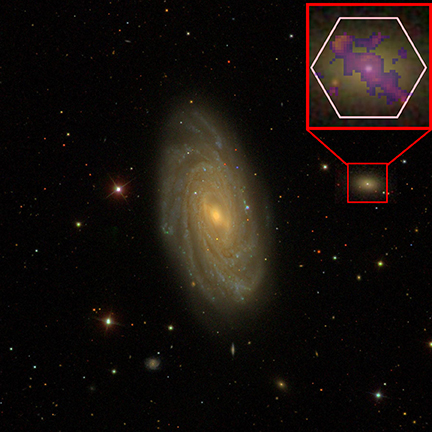Sloan Digital Sky Survey | 2018 Jan 09
Why do galaxies stop making new stars?
Today, astronomers from the Sloan Digital Sky Survey report a surprising new answer to that important question: feedback from supermassive black holes blocks star formation, even in some of the smallest galaxies.
[c]The results, being presented at the American Astronomical Society (AAS) meeting in National Harbor, Maryland on Thursday and soon to be published in the Monthly Notices of the Royal Astronomical Society, represent a major step forward in our understanding of how dwarf galaxies — some of the smallest in our Universe — are prevented from forming stars. ...
One of the dwarf galaxies that the team found to contain a red geyser. Its red
color shows it is no longer forming new stars. For size comparison, the dwarf
galaxy is shown next to a galaxy similar to the Milky Way. The dwarf galaxy
contains about 3 billion stars, while the spiral galaxy contains about 300 billion.
The inset (top right) shows a larger image of the dwarf galaxy overlain with
some of the MaNGA data for this galaxy, which revealed the winds from the
supermassive black hole. Darker purple regions show gas heated by winds from
the galaxy’s central black hole. These winds are what stops the galaxy from
forming new stars. Credit: Samantha Penny (Institute of Cosmology and
Gravitation, University of Portsmouth) and the SDSS collaboration[/c][hr][/hr]
In any galaxy, stars are born when clouds of gas collapse under the force of their own gravity. But stars don’t keep on being born forever — at some point, star formation in a galaxy shuts off. The reason for this can be different in different galaxies. Sometimes, a galaxy simply runs out of gas, exhausting its star-making fuel. Sometimes, its gas heats up so much that the excited gas defies collapse into new stars. Sometimes, its gas is pulled out of the galaxy by a gravitational interaction with a nearby galaxy.
And sometimes, the galaxy’s own central black hole is the culprit. Most galaxies have a supermassive black hole at their centers, and understanding the connections between it and the rest of the galaxy has been an important area of research for astronomers for years. Eighteen months ago, SDSS astronomers discovered a new way in which galactic black holes can shut off star formation, which they named a “red geyser.”
That discovery, as well as the results being reported today, were made possible by the SDSS’s Mapping Nearby Galaxies at Apache Point Observatory (MaNGA) survey. Whereas most prior surveys had looked at each galaxy as a single entity, MaNGA uses more than 1,000 optical fibers to make detailed maps of seventeen galaxies at a time, seeing each galaxy in detail all the way from its center to its outskirts. This observing strategy enables discoveries which link the central black hole to the rest of the galaxy — like red geysers. ...
SDSS-IV MaNGA: Evidence of the importance of AGN feedback in low-mass galaxies - Samantha J. Penny et al
- arXiv.org > astro-ph > arXiv:1710.07568 > 20 Oct 2017
